Don't wanna be here? Send us removal request.
Text
May 29- Nara
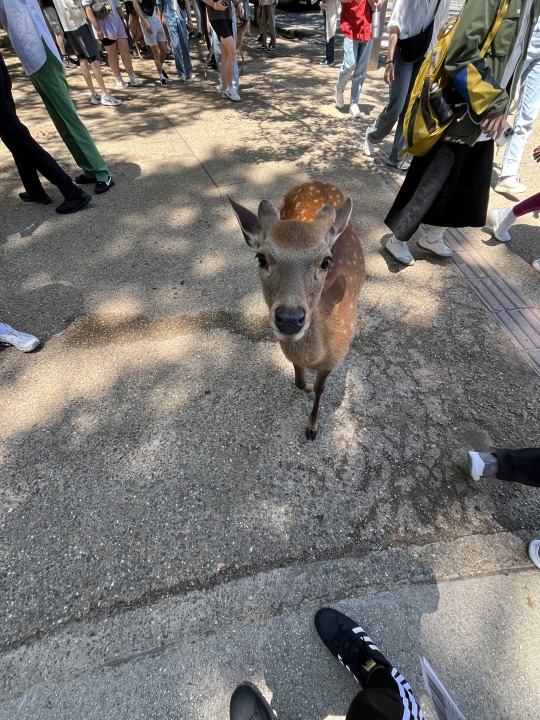
With my family members constantly presenting the same question of when I am going to see the deer and Nara, today felt like it was going to be a nonstop photoshoot. On the way there, the beautiful colors of Kyoto illuminated by the clear, sunny skies had me taking videos out the window (probably especially because of the rain we faced yesterday). When we arrived, it almost felt like the deer came out of nowhere. I really expected them to be all gathered in one general park area, but having them roam around the city was a funny revelation. I wasn’t really into the idea of feeding them as much as I was with the monkeys, but I still made sure to take many pictures and videos. Even the walk up to Kasuga Taisha had the occasional deer, which made me wonder just how far people carry their senbei for the deer to go out that far. Todaiji was also really fun, especially watching everyone pass through the nostril hole. I personally was not interested in doing it myself, as I had bashed my knee against a wall this morning (which explains the umbrella walking cane), but I was impressed by how many people could actually fit through such a small space. After we were done in Nara, I headed back just to re-organize my luggage again. Today was definitely the perfect day to experience Nara with the nice weather that we had.
Academic Reflection

Today’s readings primarily focused on the characteristics and significance of Vairocana, the history and teachings of Tendai, Shingon, and Mahayana Buddhism as a whole. When we went to Todaiji, I was reminded of the readings’ description of Vairocana and Dharma-kaya. Vairocana is supposed to be the Dharma-kaya form of the original Buddha (Siddharta Gautama). Looking at the statue of Vairocana at Todaiji, it was almost too obvious that the being involved had something to do with the original Buddha. In fact, I found it indistinguishable from any other statue of the “transformation body” of Buddha except only by name. As such, it was revealing to learn that the depiction of a dharma body in Buddhism does not need to have very distinct differences from its transformation body equivalent.
Another observation I made involved the statue of the bodhisattva Bhaisajyaguru outside of the temple. He represents the Buddha of healing, and rubbing his statue before rubbing an injured part of your body is supposed to help heal it. This emphasis on healing others reminded me of the reading’s explanation of how, in Mahayana Buddhism, bodhisattvas have the task of compassionately helping others. These acts of compassion can take a variety of forms. It seems that Bhasiajyaguru specializes in compassionate acts of actual physical care in the maintenance of good health. This led me to wonder the history behind Bhasiajyaguru’s path to Buddhahood and why specifically good health is now associated with this figure.
0 notes
Text
May 28- Himeji
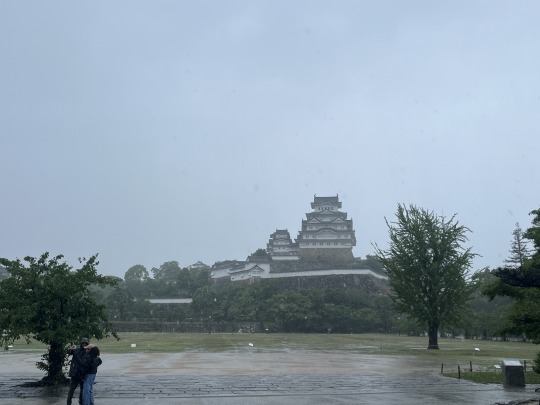
All of the day trips during our study abroad so far have been amazing, so I was excited this morning (especially because Himeji seems like a much smaller city than the environment we’ve surrounded ourselves with). Everything about the long train ride there, the train station in Himeji itself, and its nearby shopping district had this kind of comfy vibe about it. However, it almost goes without saying that the rain was brutal. My dress shoes were pretty much destroyed after all of our walking today, and when I realized I lost my umbrella, the wet run back to the entrance of the castle really messed up my clothes and my hair. I still had a good time joking with everyone else about the ridiculous situation. However, when we broke off for the day, I realized that I should probably just buy some new clothes, so I didn’t go back to the train station with everyone else. I couldn’t find much in the shopping district, so I literally just changed into a Family Mart shirt and socks with Daiso flip flops just so I didn’t have to ride the long train in my gross clothes. I took the wrong train at some point, which was tough while exhausted, but eventually I was able to make it back to the hotel to charge my phone, change, and go out to get new shoes. Despite the obvious difficulties faced today, I can feel good about how everyone faced those challenges.
Academic Reflection

The readings for today’s activity covered the evolution of Japanese practices of castle building along with the organization of castle towns and the extent of daimyo influence in their societal operations. One topic mentioned in the readings that came to mind when walking up to the castle was the way in which.h The Maeda planned the layout of their castle in Kanazawa. The emphasis on placing the castle on high ground near the center of the city, surrounded by moats and canals, seemed to reflect the location of Himeji Castle. I wasn’t sure of its exact location, but stepping out of the station and seeing the castle definitely gave the impression of a “centerpiece”. There definitely was at least one moat to cross that contributed to this centerpiece image. It seemed really interesting to walk in the same path (made comfortable) that was intended to deter invaders so long ago.
One other way in which I was reminded by the readings was in paying attention to the castle’s elevation. The readings described how Japanese castles are often constructed in places of high elevation in contrast to European castles, where high elevation is artificially constructed through walls. The gradual upward climb to the mountain generally did give the impression of a tactical advantage for the centerpiece mountain, with all of its vantage point musket holes. It also appeared that some Yamashiro reinforced the hills by the moats, with large stones lining the slopes. It was very interesting to see how the historical residents of Himeji took advantage of their natural environment to allow their castle to be tactically ideal.
0 notes
Text
May 27- Arashiyama Bamboo Forest and Monkey Park
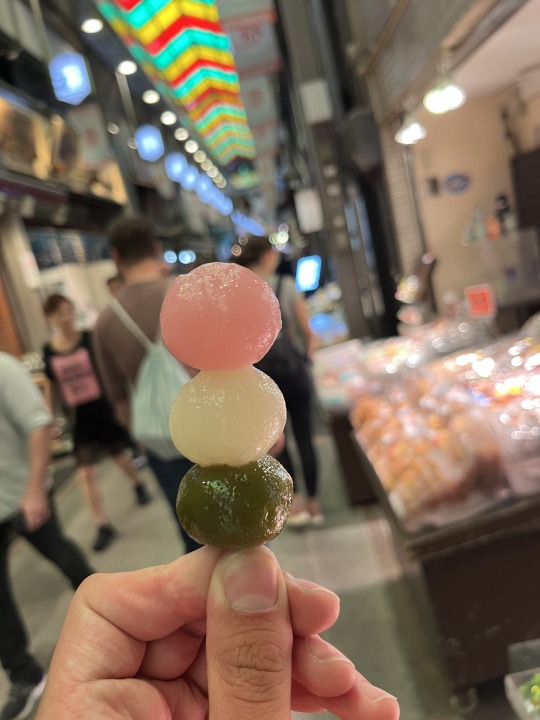
Being the insane monkey fan that I am (specifically the Golden Lion Tamarin is my favorite animal for which I maybe own a collectible mug), I was smiling nonstop whenever the monkey park visit was brought up. However, the bamboo forest visit was also not to be ignored. I actually really liked the way the light rain made it feel like a little rainforest. Despite this, was still thinking about the impending monkeys the whole way through. When we got there, I realized that it was the same park that the girls from K-On! visited so I was even more excited. I really loved how comfortable they seemed just walking right up to people, and I took lots of pictures of monkeys just chilling either by the waterfall or on trees in front of the view of the city. Feeding the monkeys was also very fun, as even having the monkeys look expectantly at me had me laughing pretty hard. After I stuck around at the park for a bit, I decided to head over to the Teramachi market just to finally have a slow stroll through all the stores. Despite everything I did in my power to stop myself, I headed in to Lashinbang, one of the anime stores, just to “look around” (I bought three more figures). I finished my day walking through all the food stalls and buying random Japanese street foods along the way. Today was definitely a good change of pace in terms of activities that very much match my interests.
Academic Reflection

The reading about the Arashiyama Bamboo Forest largely involves an analysis of how its methods of preservation have evolved throughout history. One very obvious thing that stuck out to me in this forest was its relative seeming lack of biodiversity compared to the typical forests seen covering typical mountains in Japan. The pictures I took of just the forst alone are only filled with bamboo as far as the eye can see. As such, it made sense that the reading stated that the current uniform nation-wide system of forest management is not sufficient to conserve Arashiiyama. It would not have been much of an activity if it was not unique, but this forest even purely looks like the type of place that would need some degree of specialized expertise in its management.

The two other readings were different excerpts from the classic Japanese play “The Tale of Genji”. The portion of “The Shrine in the Fields (Nonomiya)” that describes that physical apparerancea hig appearance of Ninomiya shrine had me seriously thinking how long such a simple tradition as a log wood torii has been maintained. This preserved name and descritption after so many years places Japan on another level of understanding in terms of patience for those who want to learn about local culture.
0 notes
Text
May 26- Kiyomizudera and Gion
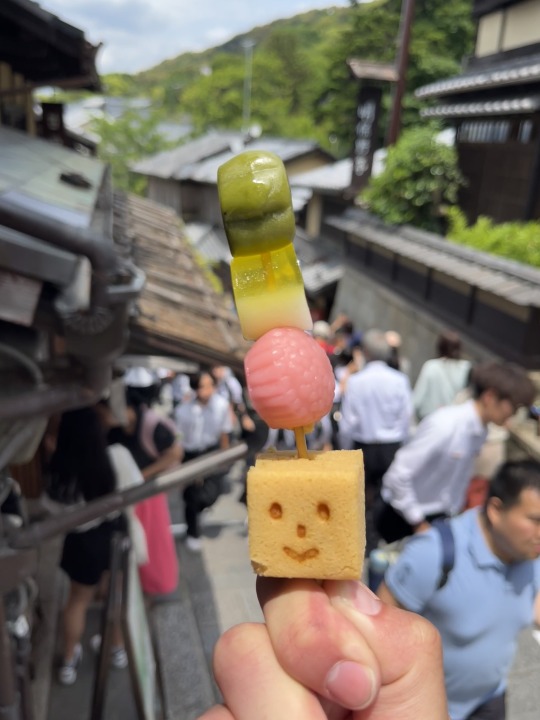
I didn’t exactly know what to expect from today, as we were visiting areas of Kyoto that I knew very little about. However, had seen anime where students visit Kiyomizudera Shrine, so it was nice to take in the sight with the group. I honestly did not expect a shrine to have such a comprehensive walkway (past the deck) that I almost accidentally lost the group on. Going to Ninenzaka was also a very nice experience. Although the crowds definitely made it hard to navigate down the streets, I really loved taking my time during our lunch break to both find some street food for myself and buy my sister some windchimes. Gion only emphasized the better parts of Ninenzaka with its quiet, small side streets. I thoroughly enjoyed using my lunch break time to simply walk independently and take pictures where it was allowed. I guess I’ve learned that I love seeing small parts of preserved historical Japan alone. When we all broke off at the geisha place, I made sure to stay behind to full appreciate everything they had on display (including the outdoor garden). After leaving Gion, I pretty much just stayed at the hotel for the rest of the day. I absolutely loved having my independent time to try new food and experience traditional Japanese culture today.
Academic Reflection
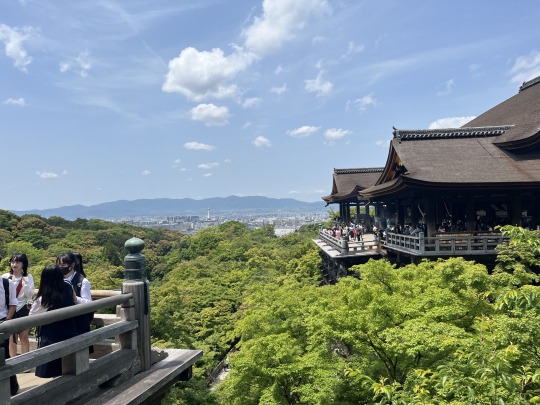
Today’s reading associated with Kiyomizudera Shrine focused on an old Japanese story about a man named Shintokumaru who deals with the karma-related consequences of his parents’ actions. Kannon’s active role in this story is largely attributed to the fact that the parents visited the representation of this bodhisattva at Kiyomizudera Shrine, where Kannon is supposedly highly responsive (as mentioned in the story). Visiting the shrine in person, it makes sense that this belief would be widely held. This shrine appeared very grand relative to many of the other shrines we have visited on this trip. The large deck constructed with large pieces of wood and no nails, the long trails going through the shrine grounds, and the abundance of traditions in such a small area (including lifting the staff and drinking from the fountain) were just some of the qualities that gave off the impression of high religious importance during our visit.
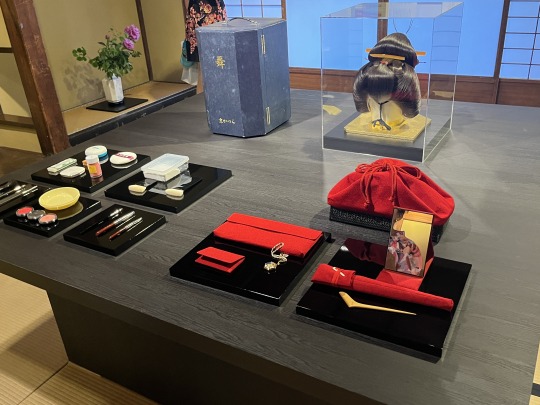
The reading associated with our trip to Gion focused on the historical role of geisha in Japanese society, with great emphasis placed on the late 19th century during the Meiji Restoration. One thing that definitely stood out to me when visiting the show was the maintained environment of formality. The serious face that the performing geisha maintained, the well-dressed polite employees helping clients with their shoes, and the way everyone seemed uncertain of the appropriateness to clap after the performance were all qualities that revealed this atmosphere. This reminded me of the complex social class differences described in the reading. The sophistication of geisha set them apart from many manual laborers and streetwalkers so long as they did not engage in prostitution. This status of distinction among the working class was understandable after seeing all of the perfect preparation (such as her intricate hair and makeup) involved in a typical geisha performance up close.
0 notes
Text
May 25- Osaka
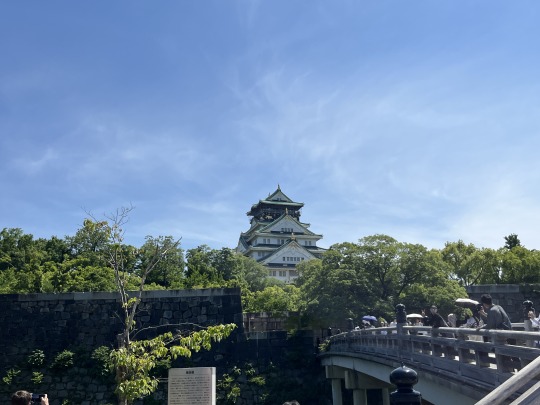
I was really excited to finally have another day-long-trip to a major Japanese city. When we finally reached Osaka, it looked like something out of a movie. The endless blue sky, buildings relatively far apart, and the various water features made Osaka look beautiful. As such, it was nice to start the day off with the observatory. The trip to Osaka castle was also pretty amazing. This clearly seemed like the largest traditional Japanese building that we’ve seen on the trip so far. As the “merchant” culture of Osaka seemed particularly interesting to me, I loved seeing all of the flashy colorful signs and small food businesses in Dotonbori. However, when we broke off there for the day, I did not spend much more time in downtown Osaka. Instead, I pursued another anime sightseeing location in Nishinomiya. It was there that I visited the high school featured in The Melancholy of Haruhi Suzumiya. This was definitely one of the better anime pilgrimages, as a lot of the area surrounding the school (such as the massive hill that I and students from the anime had to walk up) was incorporated into the show’s setting. As such, all of the pictures that I took were outside. Although it was probably the most exhausting day I’ve had during this program (thanks to the Haruhi hill), I’m glad that I was able to fit so much into one day.
Academic Reflection
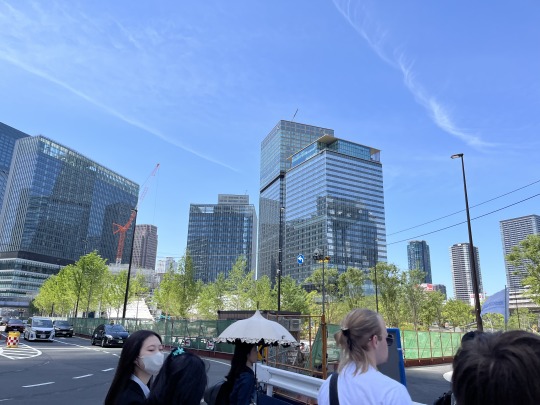
Today’s reading focused on the culture and laws surrounding the Japanese organization of major cities, specifically referencing Kobe and Osaka as examples. One thing mentioned in the reading that I’ve noticed in-person In Osaka is the large amount of free natural space as a break from the city. When we stepped out of the train station and I saw Osaka for the first time, the city looked like some fictional story with the sheer number of trees growing in between and, in some cases, on top of buildings. I had never seen such a blended collaboration of natural life iand urban structures in a major city before.
Another phenomenon pointed out in the articles was the heterogeneous methods of land usage in the city. Although similar setups were also true in Tokyo (where they were very convenient), it felt like, no matter where you were in Osaka (or how far removed the neighborhood is from commercialization), there was always some convenience store nearby in case you needed it. The choice to have retail businesses among housing and business areas seems like a perfect method by which traffic over major forms of transportation could be reduced. Such differences had me wondering whether there is any particular reason why these policies have seemingly not been very much adopted or considered in the US. Maybe there’s some legitimate practical or cultural reason as to why these conveniences and aesthetically pleasing environments can only be found in Japan.
0 notes
Text
May 24- Kinkakuji and Daitokuji

I was extremely excited for today, as the number one activity that stood out to me when first looking at the itinerary was Kinkakuji. I had always wanted to visit this temple long before the start of our trip (I even often looked at its Google 360 view in high school). When we got there, it was exactly as beautiful as I imagined it. Although the crowds were pretty ridiculous, I got some amazing pictures. I even bought a non-anime-related souvenir for once when I got a little art print of the temple at the nearby gift shop. Daitokuji was also a pretty great experience, as it was nice to be able to sit in the quiet and think for a bit. I feel like Kyoto has somehow felt more exhausting than Tokyo lately, so this was especially nice. During our breakoff time, I continued my anime shopping from yesterday, but today’s store was Mandarake. It was much better than both its Shibuya and Akihabara locations and definitely much better than the Kyoto Bookoff. I ended up buying a whole bunch of volumes of Animage and character song CDs. When I got to the hotel, I decided to use my time at least somewhat productively and finally got around to organizing my luggage. Today felt packed with satisfying moment after satisfying moment, and I’m glad that I was able accomplish so much.
Academic Reflection
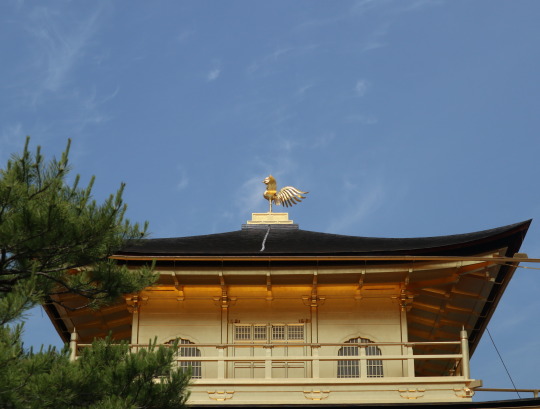
Today’s readings on Kinkakuji involved both a fictionalized backstory about the man who burned down the temple and an analysis of Medieval Japan, which is the period in which the temple was first built. The text on Medieval Japan describes Yoshimitsu, the Ashikaga shogun who presided over the construction of Kinkakuji, as a highly experienced and regal leader with great appreciation for the arts. Looking at the temple today and understanding its fairly recent reconstruction, it is understandable to conclude that Kinkakuji itself reflects these grand artistic characteristics of Yoshimitsu. The gold does not only appear to act as a flaunting of wealth but as a visually appealing design choice. It definitely stood out in terms of appearance compared to all of the other shrines and temples we have visited so far. As such, possibly without even knowing Yoshimitsu’s characteristics as described in the book, one can easily conclude that the individual who oversaw the construction of such a temple would be a highly artistically inclined individual.
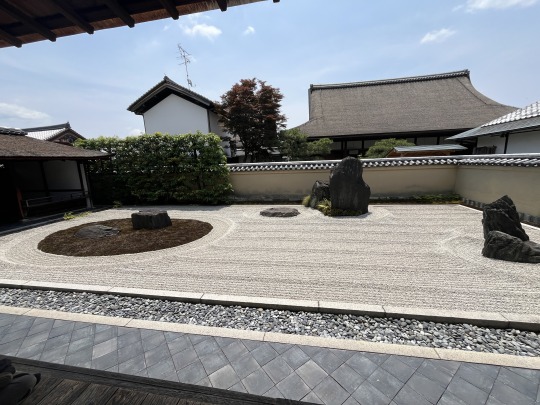
The readings related to our visit to Daitokuji focused on the history of Zen culture, the significance of certain designs in “zen gardens”, and the modern debates over the use of the phrase “zen garden”. One characteristic of the gardens seen today that clearly paralleled with the readings was the use of gravel to represent water and appear as ripples. The text explains how such ripples portray individuals who throws themselves into the sea of Buddha in pursuit of enlightenment. In this case, the boulders that I saw at the garden would represent such individuals, with the surrounding not-yet-rippled gravel representing the sea of Buddha with opportunity for enlightenment.
0 notes
Text
May 23- Kyoto Animation
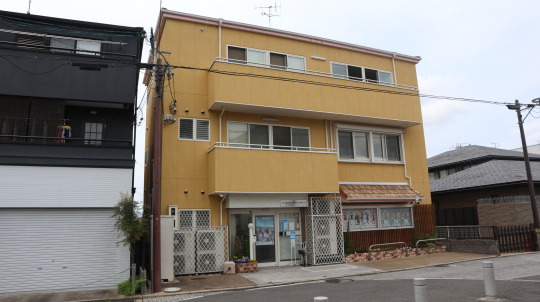
Today was another free day where I fulfilled a long-held desire to visit an anime-related location in Kyoto. I felt that, even though there is pretty much nothing to do but take pictures of the buildings, it was almost a personal duty to see the Kyoto Animation studios in person. Although I was definitely excited, as Kyoto Animation has consistently produced by far my favorite anime series in the past, there was simultaneously a tone of melancholy about today. The arson attack at their first office building from a couple years ago took the lives of so many individuals that I had admired very much. I used to watch the behind-the-scenes videos on the DVD extras for Kyoto Animation series for hours, in which the producers would show how they travel to certain on-site locations to learn more about the subject matters of their anime. Despite this, it was still an amazing feeling to see two of their studios right outside of Kohata Station along with many other fans who also had their cameras out. It reminded me of how Kyoto Animation even depicted characters of their own anime, Lucky Star, visiting their studios during the show’s Kyoto class trip episode. As Apple Maps was being relatively difficult again, looking at these studios pretty much took up my entire morning and early afternoon after I pursued the wrong location a couple times. It was still very nice to get out of the busy sections of Kyoto and finally consistently count on the train not being packed. I later headed over to Bookoff and confirmed my suspicion that the best used anime/manga merchandise stores are in Japanese cities smaller than Tokyo. At least in terms of the media that I enjoy, this place had it all. I had been looking for the Lucky Star manga for a while now, and I was so surprised that they actually had it. I even bought the Future Diary manga, which I was previously taking pictures of at the manga museum. In the end, I bought so many things that the employee was having trouble fitting them into one of the large 5-yen bags. Afterwards, I pretty much just went back to the hotel, bought dinner, and started my daily work. Although today was a rather chill way to spend my free day, I was satisfied to see the location in which some of my favorite media of all time is created. I also finally got to do the serious anime merchandise shopping that I didn’t manage to get done in Akihabara.
0 notes
Text
Independent Media Excursion: Toyosato Elementary- May 21
Traveling to Toyosato Elementary
From the moment that I saw the requirement to undergo an excursion related to a media representation of Japan, I knew that I wanted to go to Toyosato Elementary. This school was used as the reference location for the Sakuragaoka High School in the anime K-On!. As I read the manga back when I was about 9 years old before subsequently watching the anime, I was absolutely filled with excitement this morning. Making it out to Toyosato was a little rough, with some inconvenient train lines, but I loved seeing the Kansai countryside and even Lake Biwa on the way there. At the school, I had to take off my shoes and put on their provided slippers. It seemed like there was unspoken rule to be extra quiet, as, despite the fact that there were a significant number of other people there, it was silent enough for the sound of my crinkling plastic bag to echo through the halls. The K-On! sections of the school were largely kept separate from exhibits of the school’s non-media-related history, which like the rest of the building were free and open to the public. I left that school satisfied that I had finally visited a destination that I had been looking at pictures of for so long.
Academic Reflection
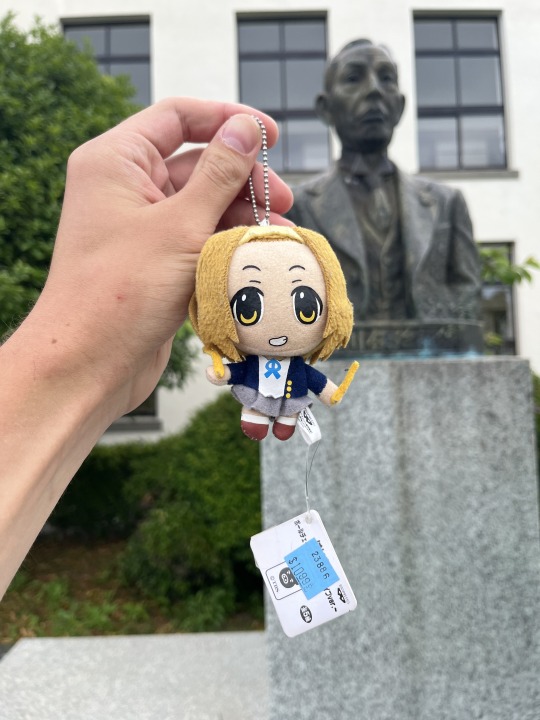
The anime that I chose for my media excursion, K-On!, is about a group of five high school girls who act as a band in the newly revived light music club at Sakuragaoka High School. The primary plot substance of this anime takes on very optimistic, lighthearted themes, as the girls learn to overcome their fears (such as stage fright), deal with feelings of inadequacy, and eventually confront the difficulties of leaving their memorable high school lives behind. The primary way in which I feel that this media represents Japan comes from how I experienced the story (both in the manga and anime) when I was young. Back then, I knew much less about Japan than I do now, yet I was approached with a story that involved an abundant execution of many modern-day Japanese cultural developments, behaviors, and tropes. This included such ideas as respect for elders, as their oddball club advisor would lecture them when they failed to refer to her as “sensei”, “manzai” comedy, with Yui Hirasawa as the boke and Azusa Nakano as the tsukkomi, and balancing a persistent work ethic (practicing instruments) with an appreciation for reflective methods of relaxation (in the form of tea parties). However, I would say that the main way that K-On! helped my younger self learn a surprising amount of Japanese culture is in the anime’s presentation of Western culture’s influence in Japan. Although I had previously enjoyed a variety of kid-focused anime and manga, K-On! was probably the first story I read to portray such an extensive fictionalized representation of daily life in Japan. As such, the idea of daily life in an East Asian country would have manifested many ideas of complete foreignness in my young mind. K-On!, with its portrayal of familiar infrastructure, pop music references, and even snack foods, was the start of this attitude of closeness that I felt with Japan. In fact, it placed Japan in a more understandable global context, as a place full of people with very deeply held emotions, hardships, and aspirations that even a 9-year-old boy in Western New York could relate to. In this sense, K-On! represents Japan by introducing universally held mindsets and portraying them in a story that depicts daily Japanese life through the employment of certain cultural developments, behaviors, and tropes.
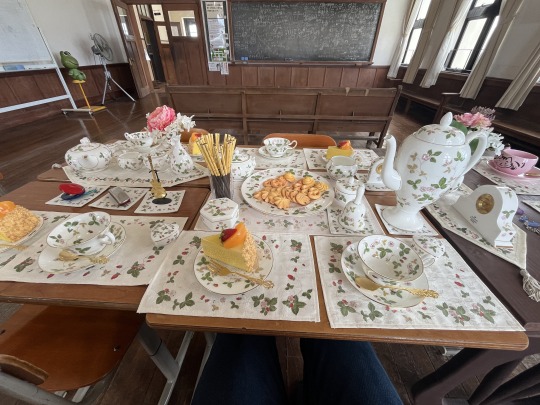
Toyosato Elementary was clearly very faithfully used as a location reference in K-On!. After so many years of watching the show, I felt like I was transported into a world of fiction when I saw the dark wood moulding along the halls, the palm trees and iconic bust outside of the school, and of course, the metallic tortoise and hare racing up the stair railing to the light music club room. Even the clubroom itself paid serious homage to K-On!, with the anime’s iconic tea set laid upon a group of desks faithfully replicated by plastic models. It’s hard to say that there were any significant differences between the anime and real life in terms of appearance, but there definitely was one in terms of the building’s function. As can be inferred, Toyosato is not a high school, but a former elementary school. It seems to now function as a well-maintained multipurpose community center and exhibit for the school’s history. There is a real elementary school that was in session next door when I arrived. As the number of fellow K-On! fans present seemed to solidify that this place was open to the public for people like me, I took advantage of the opportunity to take pictures of every location that was featured in the show. The auditorium stage where the club performed, the window-abundant hallway where they had emotional reflections, and the classrooms themselves made me feel like I was meeting some unnamed celebrity with how closely they resembled their TV counterparts. It definitely made me reflect on how much I appreciate K-On! after being able to stand where the characters stood. I truly have K-On! to thank for inspiring my initial appreciation for Japanese culture. Without it, my life would look drastically different, and I probably would have never even been led to join this study abroad program. Considering this, it only seemed right to give my due respect to this anime and manga and visit the real-life version of the location where those characters taught my younger self so many valuable lessons. This excursion was definitely worth my time in finding a media representation of Japan.
1 note
·
View note
Text
Independent Academic Excursion: Tokyo Tower- May 10
Article: Tokyo Tower and Tokyo Skytree: History and Symbolism in Contemporary Japan by Yunuen Ysela Mandujano-Salazar- https://www.semanticscholar.org/paper/Tokyo-Tower-and-Tokyo-Skytree%3A-History-and-in-Japan-Mandujano-Salazar/89575e1e56d1b3481321c8135c1d610082fc8fa2
Summary
This article discusses the history, cultural significance, and physical appearance of Tokyo Tower and Tokyo Skytree. Mandujano-Salazar mentions the contrast between past and present perceptions of the Tokyo Tower’s symbolism, its media portrayals, the inspiration behind its design, and its status as a tourist destination.
Traveling to Tokyo Tower
Tokyo Tower felt like an obvious choice to travel to for my independent excursion. Throughout my childhood, I read and watched media, such as Sailor Moon and Tokyo Mew Mew, that depict Tokyo Tower as a powerful architectural symbol to bind the characters and their setting to the real world. Although we saw its peak when walking in and out of the Tokyo American Club, I felt the need to see it during the daytime when it stands out in red and white among the other buildings (without the lights). I also really wanted to be able to see its base. As such, I took the train over and found a good spot to admire it without any crowding buildings. Pictures do not seem to do justice to the massive size of the tower. It almost had an intimidating presence when I could occasionally see it from far away through building clearings. However, I was not exactly interested in paying to go up onto its observation decks, as we had already been up the much taller Tokyo Skytree (which probably gave a better view). Despite my recent habit of hopping trains to constantly get moving to other places in Tokyo, after I took my pictures of the tower, I ended up just sitting by its base and looking up at it for a solid 45 minutes. Just about the only thing that kept me from staying there longer was my self-discipline to be back at the hotel before dark. Tokyo Tower really had me thinking about the immense and internationally recognized cultural importance of the city through which I have going on excursions. It was definitely a good choice to take my time with this sight given how much more I was able to appreciate Tokyo afterwards.
Academic Reflection

It seems almost painfully obvious to state that Tokyo Tower represents so much more than the functional tourist destination that so many Americans visit on their trips to Japan. An analysis of its symbolism calls to attention the initial intent behind its construction. Mandujano-Salazar describes how Tokyo Tower’s historical context involves Japan wishing to display an icon of their rapidly growing and hopeful nation in the years after World War II and the American occupation. Specifically, Hisakichi Maeda, founder of the Nippon Television City Corporation, intended to build a broadcasting tower that resembled the Eiffel Tower but bigger. After visiting the tower, I can say that he definitely succeeded in terms of constructing a truly grand representation of an optimistic society. Now that I’ve seen the base in person, the way it is divided into four “legs” to anchor itself to the ground really reminded me of the Eiffel Tower. Its exaggerated stature, shooting off into a point towards the sky, gave off the intended impression of the growing world power that Japan was in the 20th century. The way it noticeably protruded from behind other buildings as I walked closer conveyed the notion of a force to be reckoned with. Even as I was leaving back to the station, nearby pedestrians were looking up at the tower from far away an exclaiming at how big it is. Considering these angles on its structure, Tokyo Tower provides a glimpse into the past regarding how the Japanese viewed their nation.

The pop culture media aspect of Tokyo Tower is another important factor in understanding the depth of its cultural significance (and one that I clearly appreciate). Mandujano-Salazar describes how many portrayals of the tower in media involve themes of magic or love. This seems to appeal to Tokyo Tower’s “softer” symbolism outside of the “growing powerful nation” portrayal. Looking at the tower’s surreal shape, impressive size, and bright red and white visuals among the many surrounding neutral-colored buildings, it makes sense that it would be romanticized in such a way. However, romanticization is not the only way Tokyo Tower fits into many stories. Mandujano-Salazar also explains that the tower is a common victim of destruction in many mid-20th-century giant monster (kaiju) films. This depiction, as stated in the article, reflects the traumatic memories of much of the Japanese public regarding what was its recent defeat (and, in many areas, destruction) at the end of World War II. It seems that, even when it was first constructed, the tower captured the hearts of Japanese people as it stood for everything that they recovered for themselves in the aftermath of destruction. Another common means by which Tokyo Tower appears in Japanese media, according to Mandujano-Salazar, is as a symbol of wealth. He states that, as it is located in a relatively wealthy area of Tokyo, its appearance in media gives off the impression that the characters are in a highly important place. This aspect of its portrayal became very understandable to me on my way to the tower. I walked there from the area around Azabu-juban and Roppongi, where there was absolutely no shortage of luxury European cars and Japan-residing Americans wearing clearly expensive clothing. Even I felt important just simply being surrounded by so many people who were enjoying their time off work by driving around in their Porsche SUVs. With so many different media portrayals, the visibility and status of Tokyo Tower as an icon of the city only grows. Even my visit could be considered the product of the tower’s abundant media-prone features. In this sense, Tokyo Tower maintains a complex role in the minds of the Japanese public and people around the world who have engaged with it by different mediums. Visiting the tower up close helped me fully understand the reasoning behind the many different perspectives that individuals maintain about such an iconic building.
0 notes
Text
May 22- Kyoto Imperial Palace and Kyoto National Museum

Today definitely felt like it was going to be a more chill day with no extensive hiking activities. The Kyoto Imperial Palace was amazing, and I think it had the best gardens we’ve seen so far during the study abroad program. Of course, I’m also learning how hot Kyoto can be compared to Tokyo, as I was getting pretty burned during our tour. When we went to the Kyoto National Museum, I was particularly interested in the archaeological artifact exhibits and the art exhibits. If I were to choose one item there that stood out to me the most, it would probably be the View of Amanohashidate by Sesshu Toyo, created during the Muromachi period. The plaque described how it depicts Amanohashidate, a region of northern Kyoto, and how the piece itself benefits from Sesshu’s observational eye and composition skills. I think the most eye opening part about this piece was my realization that the stream mountains depicted are, in reality, in the same general environment as the ones that I passed on my way to Toyosato. The fact that they were covered in clouds in this piece reminded me of when we visited the cloudy areas of Mt Takao and Hakone. I guess it felt strange to think that the piece was an interpretation of something that I’ve seen frequently on this trip, but created by a Japanese man who lived during the 15th and 16th centuries. It was weird to think that I had even such a mild connection to the world that existed so many centuries ago many centuries ago. After finishing up in the museum, I finally bought another suitcase and headed back to the hotel room to finish my writings on my independent excursions.
Academic Reflection
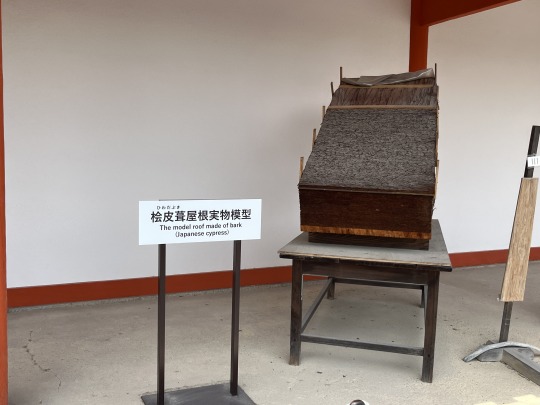
Today’s reading focused primarily on the historical organization of Kyoto and its forms of architecture. One recurring theme mentioned in the reading that I even remember from the class readings on historical Tokyo is the past extreme destruction of fires. Earthquakes and fires were such a common issue in Kyoto that they even disrupted the symmetrical organization of the city. Such disasters are part of the reason why original examples of shinden houses no longer exist. As such, it was really a cool fact when we went to the imperial palace and the tour guide mentioned how some of the buildings used to be connected by hallways that were later removed to reduce the fire hazard for the emperor.
One subject of the reading regarding architectural styles was the way in which shinden, being a distinctly Japanese style, used bark-shingled (cypress) roofs. The guide explained how, even back during the Heian period, the bark was extracted from trees sustainably, allowing it to regrow on the same trees. It reminded me of our previous reading on the forest usage rights established throughout Japanese history. It seems that the people of Japan always seemed to have a certain mindfulness for the preservation of what they take from nature.
0 notes
Text
May 21- Toyosato
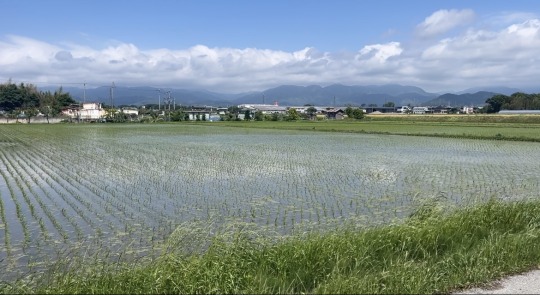
Today was one of the few free days that I had planned out well before the start of the trip. I planned to go to Toyosato Elementary School, as it was used as a reference for the school in the anime K-On!. I ended up waking up a little bit later than ideal, and I had a lot of trouble with the local Kyoto trains on the way there. I even had to walk 45 minutes from the final station to the school itself in Toyosato (on the East side of Lake Biwa). However, it was all definitely worth it, as K-On! is a manga and anime that I have obsessed over for about a decade now. I even saw a bunch of other guys about my age just walking around and taking pictures. When I was done and starting the 45-minute walk back, I actually found it nice to have some quiet time in the Japanese countryside. As such, I took a bunch of videos and pictures of the rice fields and distant mountains. The rest of the day was a little bit more frustrating. I had hoped to be able to buy a suitcase sometime soon, so I followed the Apple maps instructions to what was supposed to be a Samsonite store. When I got there, it turned out to just be a Samsonite company office space. I decided to temporarily give up on the suitcase endeavor and visit the Kyoto Animation studio, another location I wanted to see in Kyoto before this trip. However, on my way there, I realized that my phone was on a low percentage and my portable charger had died. I barely had enough on the train ride back to Kyoto Station and ended up using the rest of the battery showing a station employee where I was travelling so she could fix my IC card fares. As such, I was left to find my way back to the hotel from Kyoto Station solely based on memory. To save my day a bit, I just got myself McDonald’s rather than finding anywhere particularly fancy to eat. I am definitely glad that I finally got to see Toyosato Elementary in person after so many years of looking at it online despite the rather frustrating end to my day. I think I’ll try to be a bit more deliberate in looking up my future independent plans around Kyoto, as the transportation system around here should clearly not be underestimated.
0 notes
Text
May 20- Manga Museum and Fushimi Inari Shrine
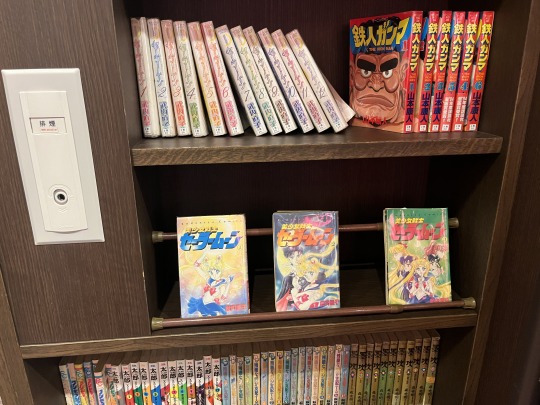
Today I woke up particularly excited to visit one of the most memorable shrines from the itinerary. Going to the manga museum, I did not exactly know what to expect, as I did not look up anything about it beforehand. As I expected it to be more informational with exhibits explaining certain aspects of the history of manga, I was pleasantly surprised by the fact that a large part of it was simply a collection of manga that could be taken off the shelves and read. Being able to actually hold a first edition copy of the first volume of Sailor Moon felt so amazing. There were also many other manga, such as The Future Diary, that I have always wanted to read in English but unfortunately are not sold anymore (but the manga art looked very nice). During our free time, I made my way to a store called Miyawaki Baisen-an to find a sensu fan as a souvenir for my Mom. Going to the Fushimi-Inari Shrine, I was amazed at the number of kitsune souvenirs being sold all around the stores at the entrance. The climb up the mountain definitely felt like one of the most tiresome walks so far on the trip, but it was very aesthetically pleasing with the tori gates and did not seem to last long. I finished off the day stopping by another fan store called Aiba to get uchiwa for my sister and myself. Today felt like a very stereotypical Kyoto day with all of the shopping for traditional souvenirs and Shinto sightseeing I’ve done.
Academic Reflection
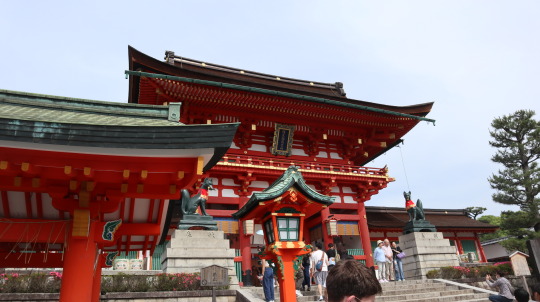
The class reading associated with our visit to Fushimi-Inari shrine covered the topic of the Japanese deity Inari, including its history, its perception and interpretation by Japanese people, and its associated imagery and traditions. The associated imagery outlined in the reading was most obviously seen at the shrine. For example, Inari’s status as a rice and fertility deity was reflected by the rice sprouts held in the mouth of one of the kitsune statues.

The statues of the kitsune themselves could also be considered part of the symbolic imagery of Inari. As the reading explains, one consensus among priests that all follow many different interpretations of Inari is that Inari is not a kitsune. I noticed that the positioning and nature of the kitsune statues at the shrine makes this belief apparent. It seemed that such statues always came in pairs, almost acting as guards to certain tori gates and structures. As it would not make sense for the singular deity Inari to be identified by two separate statues that merely stand guard to parts of the shrine, it was easy to see how the kitsune is often simply a religiously symbolic icon associated with Inari. As such, it was very interesting to put the pieces of the fragmented Inari worship described by the reading together and hypothesize the ways in which Fushimi-inari shrine respects Inari.
1 note
·
View note
Text
May 19- Travel Day to Kyoto
I was particularly excited to see what Kyoto was all about, as I’ve been enjoying the mountain activities so far (and I’ve seen pictures of how Kyoto is a little bit more obviously placed in the mountains). However, it was not fun to realize how much I underestimate the number of souvenirs I bought while studying abroad so far. I only had my duffle bag and another bag to carry some pretty heavy items, so walking through the stations was tough. I didn’t let that stop me from enjoying the shinkansen, which had some pretty nice views outside the window. When we finally got to Kyoto Station, I didn’t exactly do much during our break, as my bags were really hurting my shoulders, so I just had some convenience store sandwiches. So far, Kyoto itself has been noticeably different from Tokyo in terms of the accessibility of businesses. It felt like convenience stores were clustered much closer together in Tokyo. I have also noticed that I don’t exactly have a preference between laying on a bed or laying on a futon on the floor. Today seemed more like a chill day just to get settled into the hotel, but so far, I’m excited for the itinerary activities planned for Kyoto.
Academic Reflection

Today’s class reading focused on the history of the shinkansen and its economic, political, and demographic impacts. One of such demographic trends mentioned was the tendency for populations to increase wherever shinkansen stops are constructed. As depopulation is a concern in many rural communities, it’s interesting to question what will happen to such communities in the future now that shinkansen are apparently passing through more rural areas. Looking outside the window today, I noticed many rice fields spread throughout the several small towns that we passed through. In that moment, I was reminded of the term “flyover state” used in the US to refer to agricultural states Midwest/Great Plains that airplanes often pass through. However, due to the article, I began to question whether the towns that I am looking at may soon grow because of the shinkansen, whether such a growth may lead to more municipal mergers, and what the locals think of the train’s presence. Maybe these towns have already been negatively impacted by the presence of shinkansen stops just far enough to cause all their local businesses to move away. In this sense, riding on the shinkansen helped me develop a visual concept of the types of towns that such a railway can so greatly economically impact.
0 notes
Text
May 18- Musashi Students
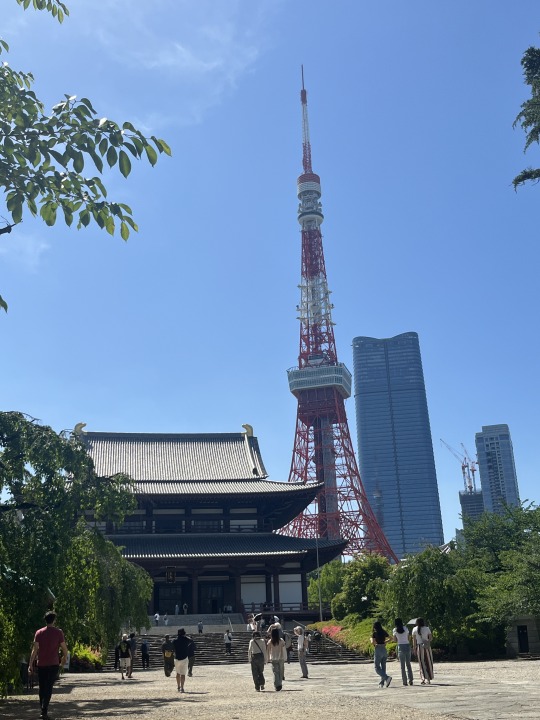
I was insanely excited for today, as I had made plans with some of the students that I met at Musashi University to go to Odaiba. This is where we walked around a mall called Diver City and along a beach that had a view of the Rainbow Bridge. We eventually walked across the Rainbow Bridge, which was much more pleasant than I originally thought it would be. In order to finally have some food of some quality substance, we stopped at a pretty decent ramen place before heading to Tokyo Tower to take some pictures. We later went to Shinjuku to visit the Shinjuku Gyoen National Garden. I was a little surprised at the fact that we had to pay to enter a park, but, when we got through the gates, I understood why. The park was packed even despite the price (which is obvious considering its placement in Shinjuku), and such a park would not exactly be enjoyable if it was significantly more crowded than it was today. The rest of the day ended up being pretty chill. We went to Ikea because I needed a big bag, walked around some more shopping centers (where we saw cool businesses like the Sesame Street Cafe), and had some dinner. Overall, I think today was an amazing day to spend time with local Japanese people who had a good idea of what to do for fun.
0 notes
Text
May 17- Fuji TV/Teamlab
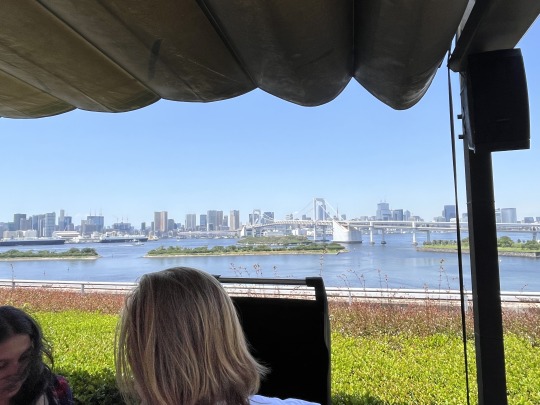
Knowing as little about Odaiba as I did, it was hard to predict what today would look like. From the class reading and some prior knowledge, I knew that Odaiba was effectively the large playground of Tokyo. When we arrived, it almost reminded me of a much cleaner version of your typical commercial shopping area in Florida. The TGI Friday’s and ToysRUs signs definitely made me feel like we were no longer in Japan. The view from the Fuji TV observation deck was the best view of Tokyo I have seen so far, with Mt Fuji, Tokyo Tower, and Tokyo Skytree all visible at the same time. The barbecue also had a similarly amazing view. As I am such a Tokyo Tower fan, it was so nice to chill and eat with a view of the tower in the distance. It almost seems like Odaiba represents everything that people generally associate with “cool” Japan, considering how, on our way to see the life-size Gundam statue, there just happened to be an active drift circuit. The Teamlab museum also far exceeded my expectations. I had seen videos online before of people walking through the light strand exhibit, but going in person, and especially seeing the koi exhibit, was an amazing experience. I think today was definitely a perfect day for engaging with some of the less serious aspects of Japan.
Academic Reflection

Today’s reading for Odaiba largely involved an analysis of “mixed land use” for the purpose of leisure. It explains how Odaiba evolved from an area known for waste dumping and protection by cannons to what is essentially a “theme park” in the city. This status was made especially clear with the certain stores present, such as the Gundam store (and of course the replica of the Gundam outside) and the general atmosphere created by factors such as intricate landscaping and self-driving buses. The reading’s described high tech, “intelligent” buildings were very obviously seen with examples such as the Tokyo Big Sight and the Fuji TV building. These created a perceived environment of a very technologically advanced business hub.
The reading’s mentioned abandonment of authentic elements of Japanese culture in favor of displays of more “exotic” Western culture created a very eerily familiar experience for me. Simply seeing an American commercial business such as Red Lobster in Japan created this sense of an intended replication of American shopping centers. Actual elements of Japanese culture actually seemed out of place. One random plaque on a sidewalk showed an array of traditional Japanese hairstyles. As such, it seems understandable that the layout of Odaiba was intended to encourage tourism (especially for foreigners) with the amount to which the area felt strangely familiar to home.
0 notes
Text
May 16- Mt Takao

Despite the group’s lingering dread for the upcoming long hike up Mt Takao, I was actually very excited to make our way back into the mountains and see some nature (after our good experience at Hakone). That’s not to say that I’m even above average in terms of walking long distances. I only consider the nature to be great motivation to ignore my exhaustion. I was a little nervous for the ski lift because I tend to not be amazing with heights, but it turned out to be totally worth it compared to the cable car once I got on. The trail along the mountain itself was amazing, knowing that we were literally in the clouds that visibly cover the tops of mountains when viewed from the base. I think the remoteness of the shrines near the top really contributed to a sort of rewarding feeling once we reached them. I also felt that the view from the summit was really amazing, even despite the lack of Mt Fuji simply, because it showed how far up we really were that we could only see the dense fog of clouds. When we broke off for the day, I made my way back down alone the same way we came and thoroughly enjoyed the views from the ski lift in the afternoon’s much sunnier weather. The rest of my day ended up being pretty light, only going to Shibuya for a quick bit and Akihabara to buy new (awful) earbuds. Today was definitely another solid day for taking things slow.
Academic Reflection
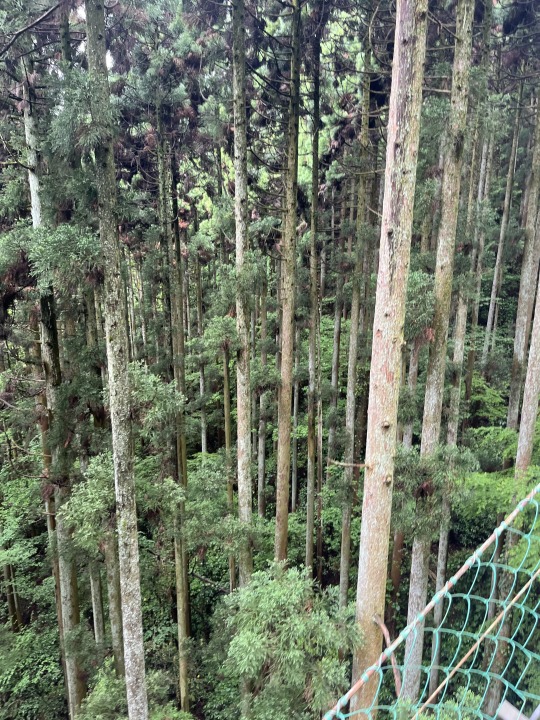
Today’s reading focused on the history of land management and forest usage methods put into action throughout Japanese history that allowed Japan to have its present abundant forests. As the reading mentions that the only location with major areas of vigin timber going into the twentieth century was Hokkaido, I was left thinking about the types of trees that were managed in the area that we saw today. The trees that I saw going up the ski lift to Mt Takao must have been affected by human practices to some degree. As such, I was wondering if there was a specific use to each of the groups of certain trees that I saw. The reading mentioned that early forest management practices often were biased towards regrowing trees that were useful to humans. One example is that the rulers typically favored control over forests that could be used for timber. Going up the ski lift, I saw some areas of the forest that consisted of groups of the same tall pine trees. As such a tree would seem ideal for logging, I was wondering whether these groups of trees had any connection to the policies of the Tokugawa bakufu.
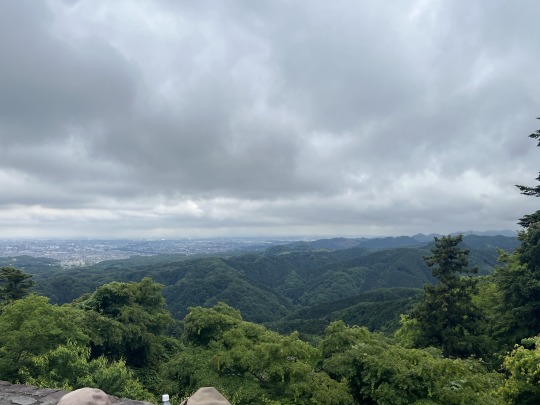
In general, learning what I did from the reading really gave me an amazing perspective when taking in the views from the mountain and realizing the centuries of forest use policies that made such views possible. The author’s describes how, without such policies, these mountains would have been barren and eroded. This seems to call to attention a powerful cultural perspective on preservation even during a time in which ecosystems were not fully understood.
0 notes